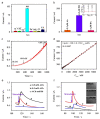Graphene nanocomposites for real-time electrochemical sensing of nitric oxide in biological systems
- PMID: 38229764
- PMCID: PMC7615530
- DOI: 10.1063/5.0162640
Graphene nanocomposites for real-time electrochemical sensing of nitric oxide in biological systems
Abstract
Nitric oxide (NO) signaling plays many pivotal roles impacting almost every organ function in mammalian physiology, most notably in cardiovascular homeostasis, inflammation, and neurological regulation. Consequently, the ability to make real-time and continuous measurements of NO is a prerequisite research tool to understand fundamental biology in health and disease. Despite considerable success in the electrochemical sensing of NO, challenges remain to optimize rapid and highly sensitive detection, without interference from other species, in both cultured cells and in vivo. Achieving these goals depends on the choice of electrode material and the electrode surface modification, with graphene nanostructures recently reported to enhance the electrocatalytic detection of NO. Due to its single-atom thickness, high specific surface area, and highest electron mobility, graphene holds promise for electrochemical sensing of NO with unprecedented sensitivity and specificity even at sub-nanomolar concentrations. The non-covalent functionalization of graphene through supermolecular interactions, including π-π stacking and electrostatic interaction, facilitates the successful immobilization of other high electrolytic materials and heme biomolecules on graphene while maintaining the structural integrity and morphology of graphene sheets. Such nanocomposites have been optimized for the highly sensitive and specific detection of NO under physiologically relevant conditions. In this review, we examine the building blocks of these graphene-based electrochemical sensors, including the conjugation of different electrolytic materials and biomolecules on graphene, and sensing mechanisms, by reflecting on the recent developments in materials and engineering for real-time detection of NO in biological systems.
Conflict of interest statement
Conflict of Interest The authors have no conflicts to disclose.
Figures






Similar articles
-
Real-time electrical detection of nitric oxide in biological systems with sub-nanomolar sensitivity.Nat Commun. 2013;4:2225. doi: 10.1038/ncomms3225. Nat Commun. 2013. PMID: 23887829
-
Recent developments on graphene and its derivatives based electrochemical sensors for determinations of food contaminants.Food Chem Toxicol. 2022 Jul;165:113169. doi: 10.1016/j.fct.2022.113169. Epub 2022 May 23. Food Chem Toxicol. 2022. PMID: 35618108
-
A review on graphene-based nanocomposites for electrochemical and fluorescent biosensors.RSC Adv. 2019 Mar 18;9(16):8778-8881. doi: 10.1039/c8ra09577a. eCollection 2019 Mar 15. RSC Adv. 2019. PMID: 35517682 Free PMC article. Review.
-
Self-Assembled Three-Dimensional Graphene Macrostructures: Synthesis and Applications in Supercapacitors.Acc Chem Res. 2015 Jun 16;48(6):1666-75. doi: 10.1021/acs.accounts.5b00117. Epub 2015 Jun 4. Acc Chem Res. 2015. PMID: 26042764
-
Strategies, advances, and challenges associated with the use of graphene-based nanocomposites for electrochemical biosensors.Adv Colloid Interface Sci. 2022 Jun;304:102664. doi: 10.1016/j.cis.2022.102664. Epub 2022 Apr 6. Adv Colloid Interface Sci. 2022. PMID: 35413509 Review.
Cited by
-
Synthesis and characterization of amine-functionalized graphene as a nitric oxide-generating coating for vascular stents.Appl Phys Rev. 2024 Sep 24;11(3):5.0192379. doi: 10.1063/5.0192379. eCollection 2024 Sep 1. Appl Phys Rev. 2024. PMID: 39355510 Free PMC article.
-
Optimizing Carbon Structures in Laser-Induced Graphene Electrodes Using Design of Experiments for Enhanced Electrochemical Sensing Characteristics.ACS Appl Mater Interfaces. 2024 Nov 27;16(47):65489-65502. doi: 10.1021/acsami.4c13124. Epub 2024 Nov 14. ACS Appl Mater Interfaces. 2024. PMID: 39539231 Free PMC article.
-
Nose-on-Chip Nanobiosensors for Early Detection of Lung Cancer Breath Biomarkers.ACS Sens. 2024 Sep 27;9(9):4469-4494. doi: 10.1021/acssensors.4c01524. Epub 2024 Sep 9. ACS Sens. 2024. PMID: 39248694 Free PMC article. Review.
-
S-nitrosocysteamine-functionalised porous graphene oxide nanosheets as nitric oxide delivery vehicles for cardiovascular applications.Redox Biol. 2024 Jun;72:103144. doi: 10.1016/j.redox.2024.103144. Epub 2024 Apr 4. Redox Biol. 2024. PMID: 38613920 Free PMC article.
-
Nitric Oxide Signaling and Sensing in Age-Related Diseases.Antioxidants (Basel). 2024 Oct 9;13(10):1213. doi: 10.3390/antiox13101213. Antioxidants (Basel). 2024. PMID: 39456466 Free PMC article. Review.
References
Grants and funding
LinkOut - more resources
Full Text Sources
Research Materials
Miscellaneous
